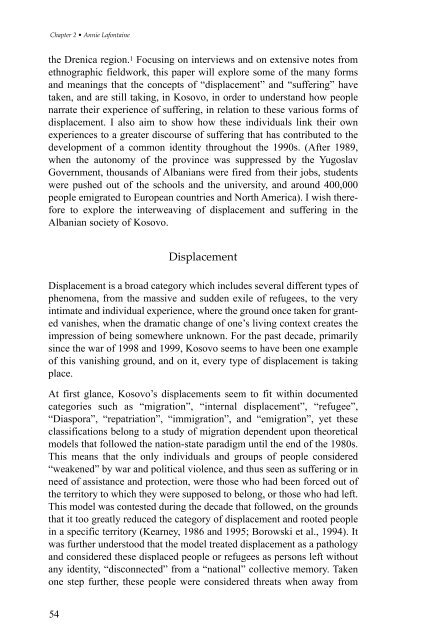Psychosocial Notebook - IOM Publications - International ...
Psychosocial Notebook - IOM Publications - International ...
Psychosocial Notebook - IOM Publications - International ...
You also want an ePaper? Increase the reach of your titles
YUMPU automatically turns print PDFs into web optimized ePapers that Google loves.
Chapter 2 • Annie Lafontaine<br />
the Drenica region. 1 Focusing on interviews and on extensive notes from<br />
ethnographic fieldwork, this paper will explore some of the many forms<br />
and meanings that the concepts of “displacement” and “suffering” have<br />
taken, and are still taking, in Kosovo, in order to understand how people<br />
narrate their experience of suffering, in relation to these various forms of<br />
displacement. I also aim to show how these individuals link their own<br />
experiences to a greater discourse of suffering that has contributed to the<br />
development of a common identity throughout the 1990s. (After 1989,<br />
when the autonomy of the province was suppressed by the Yugoslav<br />
Government, thousands of Albanians were fired from their jobs, students<br />
were pushed out of the schools and the university, and around 400,000<br />
people emigrated to European countries and North America). I wish therefore<br />
to explore the interweaving of displacement and suffering in the<br />
Albanian society of Kosovo.<br />
Displacement<br />
Displacement is a broad category which includes several different types of<br />
phenomena, from the massive and sudden exile of refugees, to the very<br />
intimate and individual experience, where the ground once taken for granted<br />
vanishes, when the dramatic change of one’s living context creates the<br />
impression of being somewhere unknown. For the past decade, primarily<br />
since the war of 1998 and 1999, Kosovo seems to have been one example<br />
of this vanishing ground, and on it, every type of displacement is taking<br />
place.<br />
At first glance, Kosovo’s displacements seem to fit within documented<br />
categories such as “migration”, “internal displacement”, “refugee”,<br />
“Diaspora”, “repatriation”, “immigration”, and “emigration”, yet these<br />
classifications belong to a study of migration dependent upon theoretical<br />
models that followed the nation-state paradigm until the end of the 1980s.<br />
This means that the only individuals and groups of people considered<br />
“weakened” by war and political violence, and thus seen as suffering or in<br />
need of assistance and protection, were those who had been forced out of<br />
the territory to which they were supposed to belong, or those who had left.<br />
This model was contested during the decade that followed, on the grounds<br />
that it too greatly reduced the category of displacement and rooted people<br />
in a specific territory (Kearney, 1986 and 1995; Borowski et al., 1994). It<br />
was further understood that the model treated displacement as a pathology<br />
and considered these displaced people or refugees as persons left without<br />
any identity, “disconnected” from a “national” collective memory. Taken<br />
one step further, these people were considered threats when away from<br />
54

















